An acceleration sensor is an electronic device that measures acceleration. Acceleration is the force that acts on an object during acceleration, just like gravity, or gravity. Acceleration can be a constant. There are two types of accelerometers: one is an angular accelerometer, which is improved by a gyroscope (angular velocity sensor). The other is a line accelerometer.
The acceleration sensor comprises a silicon diaphragm, an upper cover and a lower cover, and the diaphragm is placed between the upper cover and the lower cover and bonded together; the one-dimensional or two-dimensional nano material, the gold electrode and the lead are distributed on the diaphragm, and The wire is extracted by a pressure welding process; the industrial field vibration sensor is mainly a piezoelectric acceleration sensor. The working principle is mainly for the piezoelectric effect of the piezoelectric sensitive component to obtain a charge amount or a voltage amount proportional to vibration or pressure. At present, the industrial field typically uses an IEPE type acceleration sensor and a built-in IC circuit piezoelectric acceleration sensor, and the sensor outputs a voltage signal proportional to the amount of vibration.

An acceleration sensor is an electronic device that measures acceleration. Acceleration is the force that acts on an object as it accelerates. There are two types of accelerometers: one is an angular acceleration sensor, which is improved by a gyroscope. The other is the acceleration sensor. It can also be divided into single-axis, dual-axis and three-axis accelerometers according to the measuring axis. Accelerometers are now widely used in game control, handle vibration and shaking, automotive brake start detection, seismic detection, engineering vibration measurement, geological exploration, vibration testing and analysis, and safety and vibration reconnaissance. Here are a few examples to better understand the acceleration sensor. The game control acceleration sensor can detect the change of the inclination angles of the up, down, left, and right sides. Therefore, it is very simple to control the direction of the front, back, left, and right of the object in the game by tilting the handheld device back and forth.
Acceleration sensor specifications1. Technical indicators for sensitivity: For an instrument, generally the higher the sensitivity, the better, because the more sensitive, the more easily the change of acceleration to the surrounding environment is felt, the acceleration changes greatly, naturally, The change in the output voltage is correspondingly larger, so that the measurement is easier and more convenient, and the measured data is more accurate.
2. Technical indicators for bandwidth: Bandwidth refers to the effective frequency band that the sensor can measure. For example, a sensor with hundreds of HZ bandwidths can measure vibration; a sensor with 50 HZ bandwidth can effectively measure the tilt angle. It is.
3. Technical indicators in the range: The range required to measure the movement of different things is different, and should be measured according to the actual situation.
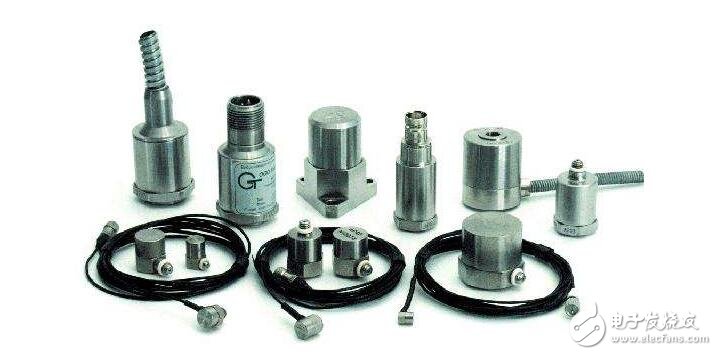
Analyze the sensor on the phone
An acceleration sensor is an electronic device that measures acceleration. Acceleration is the force that acts on an object during acceleration, just like gravity, or gravity. Acceleration can be a constant, such as g, or a variable. Therefore, its range is larger than the gravity sensor, but generally refers to the gravity sensor when the mobile phone is mentioned as an acceleration sensor, so the two can be regarded as equivalent.
Direction sensor
The mobile phone direction sensor is a component that is mounted on the mobile phone to detect the direction of the mobile phone itself, rather than the function of the compass that is generally understood.
The mobile phone direction detection function can detect that the mobile phone is in the vertical, inverted vertical, left horizontal, right horizontal, and up and down states. The mobile phone with direction detection function is more convenient and more user-friendly. For example, after the phone is rotated, the screen image can be automatically rotated and switched to the aspect ratio. The text or menu can also be rotated at the same time, making it easy for you to read; when listening to MP3. Someone might say: Is this the same as the gravity sensor?
The two are different. The direction sensor or the application of the angular velocity sensor is suitable. The direction sensor on the general mobile phone senses the azimuth, rotation angle and tilt angle on the horizontal plane. If you might think a bit of theory, let me give you an example. A city racing game with a good direction sensor. Only gravity sensors can play, but the results are very tangled.
In order to obtain highly realistic test data, the user should have a comprehensive understanding of the operating characteristics of the instrument used, how they interact with each other, how the entire environment affects these characteristics, and how the accelerometer affects the measured motion.
Accelerometers are key measurement components and are available in a variety of designs. Each design is designed for specific uses in order to obtain high fidelity measurement data.
Engineers should carefully analyze the measurement requirements, select the most appropriate accelerometer, and usually compare the sensitivity, weight and frequency response range to make the most suitable choice.
The main working characteristics of the sensor are divided into two types: effective response and spurious response.
â— Effective response effecTIve response
The response of the sensor caused by the input mechanical vibration or shock in the direction of the sensor's sensitive axis. This response is expected when the sensor is properly used for measurement and reliable data is obtained.
â— spurious response
The response of the sensor caused by other physical factors that exist simultaneously when using a sensor to measure mechanical vibration or shock. This response is interference with correct measurements and is undesirable. (See national standard GB/T 13823.1-93)
The main effective responses are:
Sensitivity; amplitude-frequency response and phase-frequency response; nonlinearity.
The main responses are:
Temperature response; transient temperature sensitivity; lateral sensitivity; rotational motion sensitivity; susceptor strain sensitivity; magnetic sensitivity; mounting torque sensitivity; response to special environments. (See national standard GB/T 13823.1-93)
â— Sensitivity: (SensiTIvity)
The ratio of the specified output to the specified input.
â—Reference sensitivity: (Reference SensiTIvity)
Sensitivity value of the sensor at a given reference frequency and reference amplitude.
The higher the sensor sensitivity, the greater the signal-to-noise ratio of the measurement system, and the system is less susceptible to static or electromagnetic fields. For a particular accelerometer design, the higher the sensitivity, the heavier the sensor and the lower the resonant frequency. Therefore, how much sensitivity is chosen is limited by its weight and frequency response.
In general, the sensitivity of the sensor includes both amplitude and phase information, which is a complex number that varies with frequency.
â—Amplitude frequency response and phase frequency response
When the value of the input mechanical vibration is constant, the amplitude of the output power of the sensor changes with the vibration frequency, which is called the amplitude-frequency response. The phase of the output power varies with the vibration frequency and is called the phase frequency response.
The amplitude-frequency response can be determined by continuously changing the vibration frequency in the operating frequency band and maintaining the amplitude of the input mechanical vibration amount unchanged while observing the output of the sensor. If the phase difference between the sensor output power and the input mechanical vibration amount is measured at the same time, the phase frequency response can be measured again.
In general, only the amplitude-frequency response is required. The sensor is used on the proximity sensor, at the lower limit frequency, or when required, the phase response must be known.
â—Nonlinearity
Within a given frequency and amplitude range, the output is proportional to the input, called a linear change. The degree to which the calibration result of the actual sensor deviates from the linear change is called the nonlinearity of the sensor.
In the dynamic range of the sensor from the minimum to the maximum, the amount of mechanical vibration input is gradually increased, and the change in the amplitude of the sensor output is measured to determine the deviation between the output value of the sensor and the linear output value. When measuring with a sinusoidal vibration generator, several frequencies can be selected within the operating frequency range of the sensor to cover the entire dynamic range of the sensor.
Generally, the deviation between the output value of the sensor and the linear value is the largest near the upper limit of the dynamic range of the sensor. The amount of deviation allowed depends on the requirements of the specific measurement.
For piezoelectric accelerometers, they are generally used in a certain range of acceleration, and the percentage of increase in sensitivity is used to indicate nonlinearity. Piezoresistive, variable capacitance accelerometers have better linearity over their dynamic range, which represents a combination of nonlinearity, hysteresis, and non-repetition.
â—The impact of mass load
If the dynamic mass of the accelerometer is close to the dynamic mass of the structure being measured, the vibration will be significantly attenuated. For this reason, when measuring vibration on a thin and light sheet member such as a printed circuit board, a lightweight accelerometer must be used in order to obtain accurate data. If the object under test exhibits a single degree of freedom response, the accelerometer will have its resonant frequency down. Micro accelerometers must be used in all modal tests.
â—Low frequency response
Using piezoelectric accelerometers, the low frequency cutoff frequency of the amplifier used is 2-5 Hz, in order to eliminate the pyroelectric output of many piezoelectric sensors. Isolated designs such as isolated shear designs can be used at lower frequencies. Piezoresistive and variable capacitance accelerometers have a zero frequency response.
â—High frequency response
The high frequency response of the accelerometer varies with the mechanical performance of the accelerometer and the method of installation. Most accelerometers exhibit the frequency response of an undamped single degree of freedom system when installed securely. At ±5%, the frequency response is approximately flat to one-fifth of the installed resonant frequency. If you add the appropriate correction factor, you can get useful data at a higher frequency.
â— Temperature response
The sensitivity of the sensor as a function of temperature is called the temperature response of the sensor. The difference between the sensitivity at the test temperature and the sensitivity at room temperature is expressed as a percentage of the sensitivity at room temperature.
Common piezoelectric accelerometers have a temperature range below zero degrees to +177 ° C or +260 ° C. For certain models, the low temperature can reach absolute zero and the high temperature can reach 760 °C. A wide variety of piezoelectric accelerometer designs have a flat temperature response over a wide temperature range. Typical temperature ranges for piezoresistive and variable capacitance accelerometers range from -18°C to +93°C.
â— Transient temperature sensitivity of piezoelectric sensors
A sensor with a pyroelectric effect produces an electrical output under transient temperature. The ratio of the maximum value of the output to the product of sensor sensitivity and temperature change is called transient temperature sensitivity.
When the temperature changes, the piezoelectric element produces an output signal, which is called a pyroelectric effect. A sudden change in the temperature of the test piece or airflow causes this temperature change. In most cases, this effect is very low frequency, and only the response of the signal conditioner can be detected below 1 Hz. If the signal conditioner has an interstage high-pass filter, special care should be taken that the pyroelectric signal may saturate the amplifier, causing it to not operate for a short period of time.
The pylon-isolated, shear-type, isolated-shear design has a small pyroelectric effect. This effect of piezoresistive and variable capacitance is negligible.
â—Horizontal sensitivity
For one-way measurements, it is necessary to require the accelerometer to not respond to the lateral motion of the object being measured. However, the accelerometer cannot be perfect. There is always a certain lateral sensitivity, which is related to the direction of the lateral vibration. The lateral sensitivity is generally 1 to 5% of the axial sensitivity. Ndfok performs a lateral sensitivity calibration of each accelerometer and gives its maximum value.
â—Horizontal sensitivity ratio
The sensitivity of the sensor when excited in a direction perpendicular to the sensor's sensitive axis is called lateral sensitivity. The ratio of the lateral sensitivity to the sensitivity along the direction of the sensitive axis is called the lateral sensitivity ratio.
â—Rotational motion sensitivity
Some linear vibration sensors are sensitive to rotational motion. Care must be taken when conducting the test. So as not to cause measurement errors.
â—Base strain sensitivity
When the sensor base generates strain, it will cause an undue signal output. The ratio of the output value to the product of the sensor sensitivity and strain value is called the susceptor strain sensitivity.
In some tests, dynamic bending, torsion, stretching, etc. may be present at the accelerometer installation. The accelerometer base also strains due to close contact with the strain zone. Part of the strain is transmitted to the sensitive component, producing an output signal that is independent of the vibrational motion.
The shear-designed accelerometer is an order of magnitude less sensitive than the compression-type susceptor strain. This effect can be reduced by applying insulating mounting screws or adhesive adapters.
â—Magnetic sensitivity
The signal is output when the sensor is placed in a magnetic field. The ratio of the output value to the product of the sensitivity of the sensor and the magnetic induction of the magnetic field is called the magnetic sensitivity of the sensor.
â—Installing torque sensitivity
With a thread-mounted sensor, changes in mounting torque can cause changes in sensitivity. The maximum difference between the sensitivity when 1/2 times the specified mounting torque is applied or the specified mounting torque is applied and the sensitivity when a predetermined mounting torque is applied, and the percentage of the sensitivity when the predetermined mounting torque is applied is referred to as the mounting torque sensitivity.
â—Special environment response
In the special environment of strong electrostatic field, alternating magnetic field, RF field, sound field, cable influence, nuclear radiation, etc., some sensors will be seriously affected. These physical factors will cause the sensor to produce a spurious response.
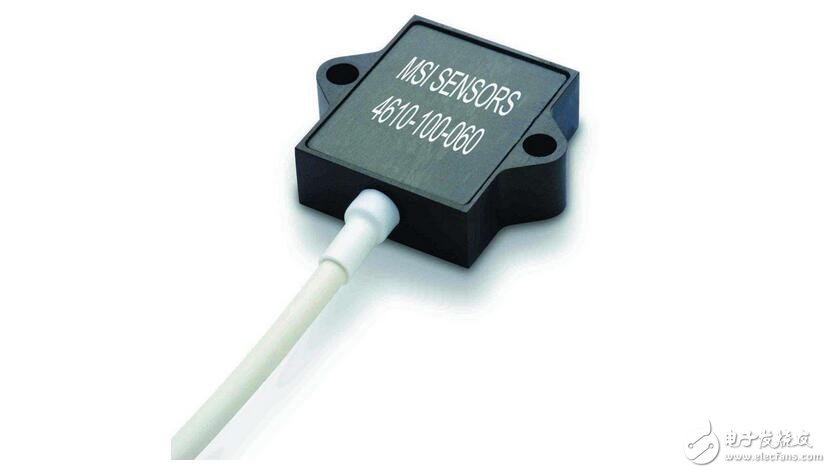
Piezoelectric accelerometers, also known as piezoelectric accelerometers. It works with the piezoelectric effect of piezoelectric materials. The so-called piezoelectric effect refers to some dielectric materials, when it is deformed by a mechanical external force in a certain direction, the internalization of the dielectric occurs, resulting in the appearance of equal-sized, opposite-symbol charges on the opposite surfaces of the dielectric. When the direction of the external force changes, the polarity of the charge is also proportional to the amount of charge that is proportional to the external force. When the external force is removed, the dielectric returns to the uncharged state. This phenomenon is called the positive piezoelectric effect. Conversely, when an electric field is applied in the direction of polarization of the dielectric, it deforms. This phenomenon is called the inverse piezoelectric effect. Piezoelectric accelerometers work with positive piezoelectric effects.
A dielectric having a piezoelectric effect is called a piezoelectric material. In nature, there are many substances with piezoelectric effect, but most of the common effects are very weak, and only a few such as quartz crystals and piezoelectric ceramics have strong piezoelectric effects.
The structural type of the piezoelectric accelerometer has three types of compression type, shear type and bending type. Figure 11-5 shows the structure of the compression type accelerometer. The sensitive component is a piezoelectric crystal piece 4, a mass 3 is pressed on the crystal piece, and a pre-tightening force is applied to the mass by a relatively rigid spring 2, and they are immersed in a thick base 6. Inside the metal casing 1. When the accelerometer is mounted on the body of the rod to be measured and then plated, the mass generates a force proportional to the vibration acceleration acting on the piezoelectric crystal piece. According to the positive piezoelectric effect, on the opposite surface of the crystal piece In the case of alternating electrical materials, the total size is proportional to the force, and the mass of the mass is fixed, so the charge on the crystal piece is proportional to the acceleration of the pulling.
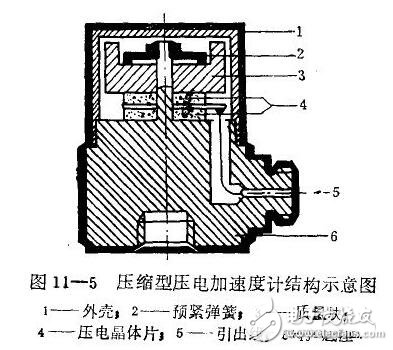
Piezoelectric accelerometers have the advantages of small size, light weight, solid structure, high frequency bandwidth, high sensitivity and wide measuring range. Piezoelectric accelerometers have good stability and are often used as standard accelerometers in vibration metrology.
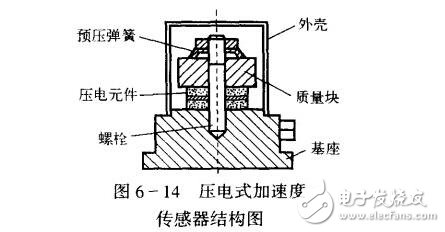
Figure 6-14 is a structural view of a piezoelectric acceleration sensor. It is mainly composed of a piezoelectric element, a mass, a preload spring, a base and an outer casing. The entire part is housed in the housing and secured by bolts. The mass is typically made of a bulky material such as tungsten or a heavy alloy. The function of the preload spring is to load the mass and generate a pre-pressure to ensure that the wafer is always compressed as the force changes. The entire assembly is mounted on the base. In order to prevent any strain of the device under test from being transmitted to the piezoelectric wafer and generating a false signal, the pedestal is generally required to be made thicker. The base is rigidly fixed to the object to be measured.
When the acceleration sensor and the object to be tested are subjected to shock vibration, the piezoelectric element is subjected to the inertial force of the mass, so that an alternating voltage or electric charge is generated on both surfaces of the piezoelectric element. When the vibration frequency is much lower than the natural frequency of the sensor, the voltage or electric charge output by the sensor is proportional to the force, so that the acceleration of the measured object can be known.
Acceleration sensor applicationBy measuring the acceleration due to gravity, you can calculate the tilt angle of the device relative to the horizontal plane. By analyzing dynamic acceleration, you can analyze how the device moves. But at the beginning, you will find that the light measurement tilt and acceleration do not seem to be very useful. However, engineers have come up with many ways to get more useful information.
Accelerometers help the robot understand the environment in which it is located. Is climbing? Still going downhill, have you fallen? Or for a flying robot, it is also crucial for controlling the attitude. What's more important is that your robot does not take the bomb to the crowd. A good programmer can use the accelerometer to answer all of the above questions. Accelerometers can even be used to analyze engine vibration.
The acceleration sensor measures the acceleration produced by the traction.
Case
Accelerometer applied to geophone design
Geophone is a special sensor for geological exploration and engineering measurement. It is a kind of sensor that converts ground vibration into electric signal. It can convert ground vibration caused by seismic wave into electric signal and convert it into binary data through analog/digital converter. Data organization, storage, and processing. An accelerometer is an electronic device that measures acceleration. It is typically used in cell phones, laptops, pedometers, and motion detection.
Acceleration sensor technology applied to car accident alarm
In the modern development of the automobile industry, the automobile has become one of the main means of transportation for people, but the number of casualties due to traffic accidents is also huge. In the modernization of information technology, the use of high technology to save people's lives will be one of the major research topics. Acceleration-based car accident alarm system is carrying this design concept. I believe that the promotion of this system will bring to the automotive industry. Come for more security.
Acceleration sensor for monitoring high voltage wire galloping
At present, the main technical solutions for wire dancing monitoring in China are video image acquisition and motion acceleration measurement. In the weather conditions such as high temperature, high humidity, severe cold, dense fog and dust, the former not only has high requirements for the reliability and stability of video equipment, but also the effect of the captured video images will be affected. In actual use. It can only be used as an auxiliary monitoring method, and it is impossible to quantitatively analyze the wire motion parameters. However, the acceleration sensor can be used to monitor the wire galloping. Although it can quantitatively analyze the up and down vibration and the left and right swing of a certain point of the transmission wire, only the amplitude of the linear motion of the wire can be measured. Frequency, but for complex circular motion, it cannot be accurately measured. Therefore, we must accelerate the development of accelerometers to adapt to such applications.
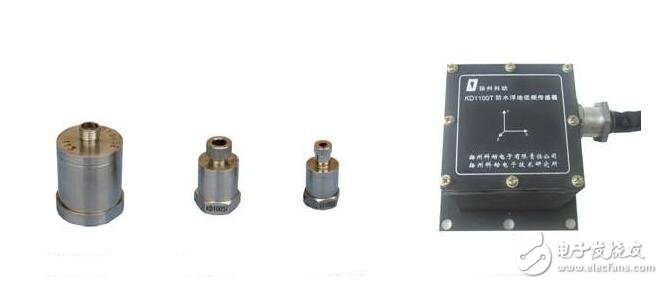
specific
Car safety
Acceleration sensors are mainly used for safety performance of automotive airbags, anti-lock braking systems, traction control systems.
In safety applications, the rapid response of accelerometers is very important. When the airbag should pop up, it must be determined quickly, so the accelerometer must react in an instant. The response time of the device can be shortened by using a sensor design that can quickly reach a steady state rather than vibrate. Among them, piezoresistive accelerometers are the fastest growing due to their wide application in the automotive industry.
Game control
The acceleration sensor can detect changes in the tilt angles of the up, down, left, and right sides. Therefore, it is very simple to control the direction of the front, back, left, and right of the object in the game by tilting the handheld device back and forth.
Image flips automatically
The acceleration sensor detects the rotation action and direction of the handheld device to achieve the positive rotation of the image to be displayed.
Electronic compass tilt correction
The magnetic sensor determines the direction by measuring the magnitude of the magnetic flux. When the magnetic sensor is tilted, the magnetic flux passing through the magnetic sensor will change, causing the direction to be inaccurate. Therefore, if the electronic compass without tilt correction is required, the user needs to be placed horizontally. The principle that the acceleration sensor can measure the inclination can compensate for the tilt of the electronic compass.
GPS navigation system dead angle compensation
The GPS system ultimately determines the orientation of the object by receiving three satellite signals distributed at 120 degrees. In some special occasions and landforms, such as ramps, high-rise buildings, and jungle areas, GPS signals will become weaker or even completely lost. This is called a dead end. By adding an accelerometer and the inertial navigation that we used in the past, we can measure the dead zone of the system. By integrating the acceleration sensor once, it becomes the amount of change in velocity per unit time, thereby measuring the movement of the object in the dead zone.
Pedometer function
The acceleration sensor can detect the AC signal and the vibration of the object. When the person walks, it will generate a certain regular vibration, and the acceleration sensor can detect the zero-crossing point of the vibration, thereby calculating the number of steps taken by the person walking or running. Thereby calculating the displacement of the person's movement. And using a certain formula can calculate the calorie consumption.
Anti-shake function
The acceleration sensor detects the vibration/shake amplitude of the handheld device, and locks the camera shutter when the vibration/shake amplitude is too large, so that the captured image is always clear.
Flash function
By waving the handheld device to display text in the air, the user can write the displayed text by himself. This flash function is to use people's visual residual phenomenon, use the acceleration sensor to detect the period of the wave, and achieve accurate positioning of the displayed text.
Hard disk protection
Acceleration sensors are used to detect the free fall state, thus providing the necessary protection for the mini hard drive. As we all know, when the hard disk reads data, the distance between the magnetic head and the disc is very small. Therefore, the slight vibration of the outside world will have a bad result on the hard disk, and the data will be lost. The acceleration sensor can be used to detect the free fall state. When the free fall state is detected, the head is reset to reduce the damage of the hard disk.
Device or terminal attitude detection
Accelerometers and gyroscopes are often referred to as inertial sensors and are commonly used in a variety of devices or terminals to achieve attitude detection, motion detection, etc., and are also suitable for people who play somatosensory games. The accelerometer uses gravity acceleration and can be used to detect the tilt angle of the device, but it is affected by the motion acceleration, making the tilt measurement less accurate, so it is usually necessary to use the gyroscope and magnetic sensor compensation. At the same time, when the magnetic sensor measures the azimuth, it also uses the geomagnetic field. When the current changes in the system or the surrounding magnetic material, and when the device is tilted, the measured azimuth is not accurate. In this case, an acceleration sensor (inclination sensor) is needed. ) and the gyroscope to compensate.
Smart product
The innovative function of the accelerometer in the WeChat function breaks through the thousands of rules of the electronic product. This function realizes the characteristics of the sensor's direction, accelerometer, light, magnetic field, proximity, temperature and other parameters. This principle is an integrated acceleration sensor inside the mobile phone, which can measure the acceleration values ​​of X, Y and Z respectively. The size of the X direction represents the horizontal movement of the mobile phone. The size of the Y direction represents the vertical movement of the mobile phone, and the value of the Z direction The size represents the vertical direction of the space of the mobile phone, the direction of the sky is positive, the direction of the earth is negative, and then the relevant acceleration value is transmitted to the operating system, and by judging the change in size, it is possible to know the friends who play WeChat at the same time.
Spinner Rotary Joint,Fiber Optic Rotary Joint,Rotary Union,Coaxial Rotary Joint
Dongguan Oubaibo Technology Co., Ltd. , https://www.sliprobo.com